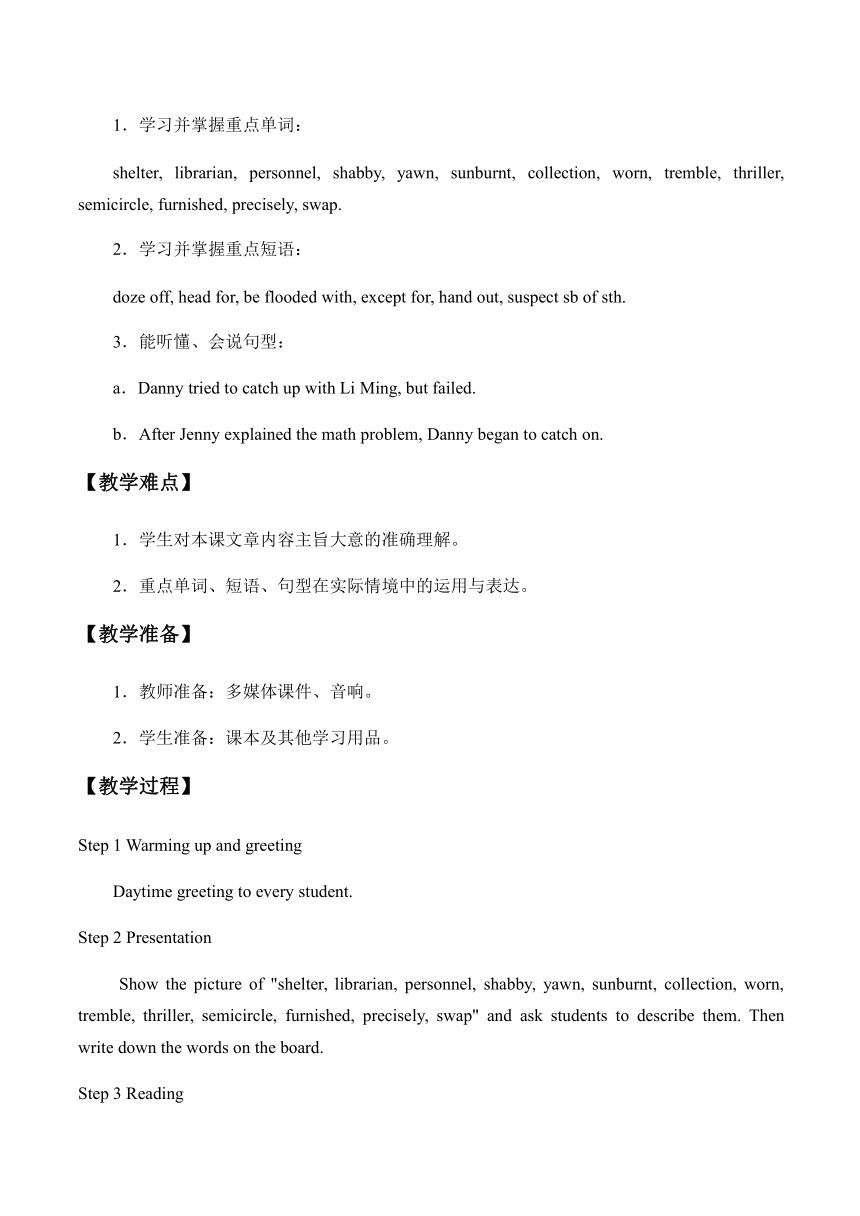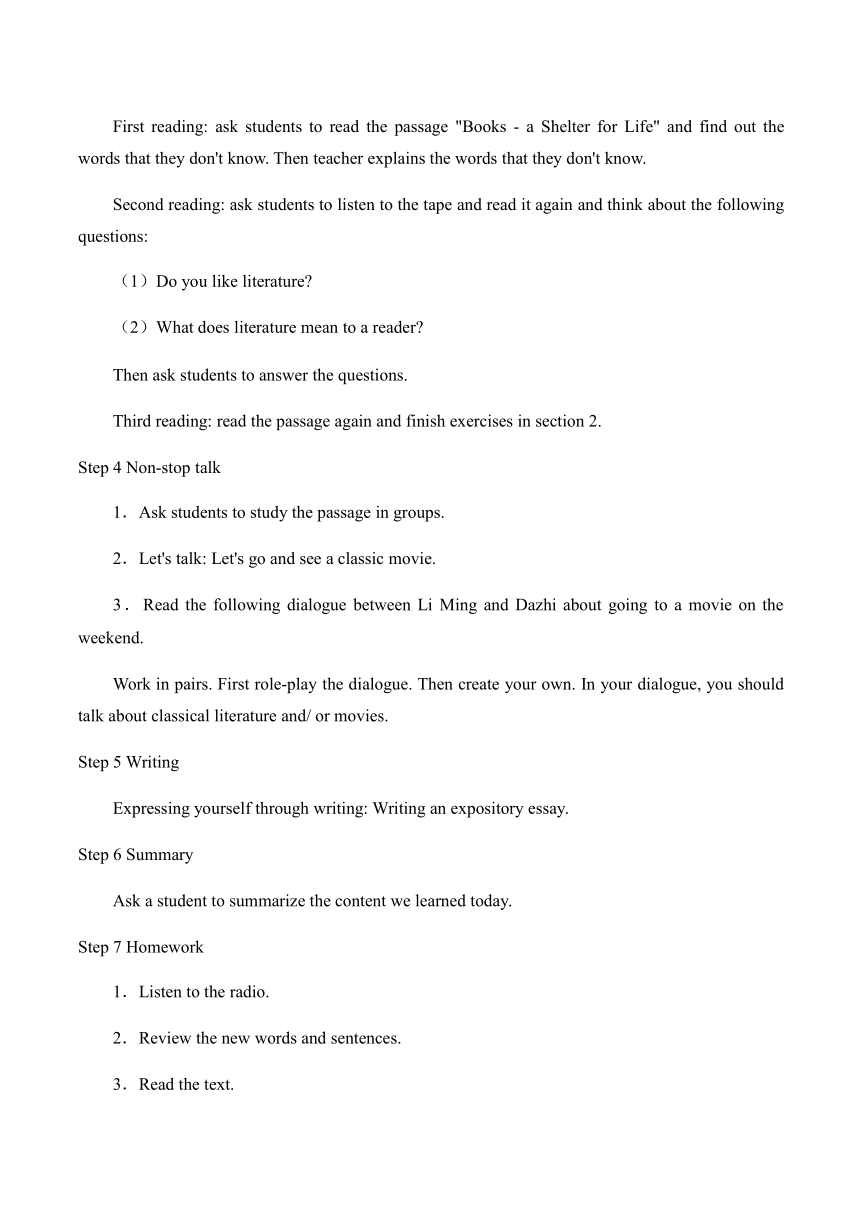冀教版选修七Unit 5 Literature for Self-understanding 教案
文档属性
| 名称 | 冀教版选修七Unit 5 Literature for Self-understanding 教案 |  | |
| 格式 | zip | ||
| 文件大小 | 32.5KB | ||
| 资源类型 | 教案 | ||
| 版本资源 | 冀教版 | ||
| 科目 | 英语 | ||
| 更新时间 | 2020-02-21 20:58:42 | ||
图片预览




文档简介
Unit 5 Literature for Self-understanding
The First Period
【教学目标】
1.知识目标
(1)重点单词:
shelter, librarian, personnel, shabby, yawn, sunburnt, collection, worn, tremble, thriller, semicircle, furnished, precisely, swap.
(2)重点短语:
doze off, head for, be flooded with, except for, hand out, suspect sb of sth.
(3)能听懂、会说句型:
a.Danny tried to catch up with Li Ming, but failed.
b.After Jenny explained the math problem, Danny began to catch on.
2.语言技能目标
(1)理解并掌握新词的及应用。
(2)理解文章主旨:通过上下文克服生词困难,理解语篇意义,提高阅读能力。
3.情感态度、文化意识、学习策略。
在“学生为主体”的思想指导下,让学生成为课堂的主人,形成有效的“生生互动”,“和谐对话”,同时借助多媒体的优势使学生主动融入课堂教学情境之中,以调动学生积极性,激发学生参与课堂的潜能,建立良好的课堂氛围,真正发挥情感教学的优势。
【教学重点】
1.学习并掌握重点单词:
shelter, librarian, personnel, shabby, yawn, sunburnt, collection, worn, tremble, thriller, semicircle, furnished, precisely, swap.
2.学习并掌握重点短语:
doze off, head for, be flooded with, except for, hand out, suspect sb of sth.
3.能听懂、会说句型:
a.Danny tried to catch up with Li Ming, but failed.
b.After Jenny explained the math problem, Danny began to catch on.
【教学难点】
1.学生对本课文章内容主旨大意的准确理解。
2.重点单词、短语、句型在实际情境中的运用与表达。
【教学准备】
1.教师准备:多媒体课件、音响。
2.学生准备:课本及其他学习用品。
【教学过程】
Step 1 Warming up and greeting
Daytime greeting to every student.
Step 2 Presentation
Show the picture of "shelter, librarian, personnel, shabby, yawn, sunburnt, collection, worn, tremble, thriller, semicircle, furnished, precisely, swap" and ask students to describe them. Then write down the words on the board.
Step 3 Reading
First reading: ask students to read the passage "Books - a Shelter for Life" and find out the words that they don't know. Then teacher explains the words that they don't know.
Second reading: ask students to listen to the tape and read it again and think about the following questions:
(1)Do you like literature?
(2)What does literature mean to a reader?
Then ask students to answer the questions.
Third reading: read the passage again and finish exercises in section 2.
Step 4 Non-stop talk
1.Ask students to study the passage in groups.
2.Let's talk: Let's go and see a classic movie.
3.Read the following dialogue between Li Ming and Dazhi about going to a movie on the weekend.
Work in pairs. First role-play the dialogue. Then create your own. In your dialogue, you should talk about classical literature and/ or movies.
Step 5 Writing
Expressing yourself through writing: Writing an expository essay.
Step 6 Summary
Ask a student to summarize the content we learned today.
Step 7 Homework
1.Listen to the radio.
2.Review the new words and sentences.
3.Read the text.
Unit 5 Literature for Self-understanding
The Second Period
【教学目标】
1.知识目标
理解并掌握短语动词用法。
2.语言技能目标
正确应用短语动词进行英语表达。
3.情感态度、文化意识、学习策略
在“学生为主体”的思想指导下,让学生成为课堂的主人,形成有效的“生生互动”,“和谐对话”,同时借助多媒体的优势使学生主动融入课堂教学情境之中,以调动学生积极性,激发学生参与课堂的潜能,建立良好的课堂氛围,真正发挥情感教学的优势。
【教学重点】
短语动词用法的讲解。
【教学难点】
短语动词的理解与掌握。
【教学准备】
1.教师准备:多媒体课件、音响。
2.学生准备:课本及其他学习用品。
【教学过程】
Step 1 Warming up and greeting
Daytime greeting to every student.
Step 2 Presentation
1.A phrasal verb is a verb + a preposition/ adverb, which results in a new verb with a different meaning. The meaning of the combination cannot usually be guessed from its separate parts.
2.Phrasal verbs are part of a large group of verbs called "multi-word verbs" Multi-word verbs, including phrasal verbs, are common, especially in spoken English. The important thing to remember is that a multi-word verb is still a verb.
3.Some phrasal verbs are transitive, while others are not.
Ask students to memorize this part for ten minus and then ask them to close books to explain the grammar from this part in their own words.
Step 3 Danny's grammar questions:
1.Look at this sentence: "He must have gone by it, because now he was in the Doyle section" What does "He must have gone by it" mean? Why does the writer use "must have gone"?
2.In the sentence "Low in the sky, geese flocked together, their cries filling the air as they prepared for their long migration south," what is the subject of filling the air?
After the discussion, students summarize the answers to the questions and make group presentations, then prepare to be evaluated by the teacher.
Step 4 Fun of the Unit!
Enjoy those fun stories in the book.
Step 5 Summary and Homework
Ask a student to summarize the grammar we learned today, and to finish other exercises this part in book.
Unit 5 Literature for Self-understanding
The Third Period
【教学目标】
1.知识目标
(1)重点单词:
vacant, bless, diverse, convey, appeal, obvious, explicitly, unlike, significance, category, medium, uncomfortable.
(2)重点短语:
confess to sth/ doing sth, in addition to, attach sth to sth, strive to do sth, as a whole.
2.语言技能目标
(1)理解并掌握新词的及应用。
(2)理解文章主旨:通过上下文克服生词困难,理解语篇意义,提高阅读能力。
3.情感态度、文化意识、学习策略。
在“学生为主体”的思想指导下,让学生成为课堂的主人,形成有效的“生生互动”,“和谐对话”,同时借助多媒体的优势使学生主动融入课堂教学情境之中,以调动学生积极性,激发学生参与课堂的潜能,建立良好的课堂氛围,真正发挥情感教学的优势。
【教学重点】
1.学习并掌握重点单词:
vacant, bless, diverse, convey, appeal, obvious, explicitly, unlike, significance, category, medium, uncomfortable.
2.学习并掌握重点短语:
confess to sth/ doing sth, in addition to, attach sth to sth, strive to do sth, as a whole.
【教学难点】
1.学生对本课文章内容主旨大意的准确理解。
2.重点单词、短语、句型在实际情境中的运用与表达。
【教学准备】
1.教师准备:多媒体课件、音响。
2.学生准备:课本及其他学习用品。
【教学过程】
Step 1 Warming up and greeting
Daytime greeting to every student.
Step 2 Presentation
Show the picture of "vacant, bless, diverse, convey, appeal, obvious, explicitly, unlike, significance, category, medium, uncomfortable" and ask students to describe them. Then write down the words on the board.
Step 3 Reading
First reading: ask students to read the passage "Understanding Literature" and find out the words that they don't know. Then teacher explains the words that they don't know.
Second reading: ask students to listen to the tape and read it again and think about the following questions:
(1)What is literature? What can we see in a literary work?
(2)How could we understand literature in a sound way?
Then ask students to answer the questions.
Read the passage "Columbus and the Egg" and think about the following questions. Then teacher explains the words that they don't know.
(1)What message does this mini-story convey to the reader?
(2)Have you ever experienced a situation that is similar to what Columbus experienced?
After the students have finished thinking about the problems, teacher emphasizes the important point or asks the students to answer the questions and checks the answers.
Step 4 Summary
Ask a student to summarize the content we learned today.
Step 5 Homework
1.Listen to the radio.
2.Review the new words and sentences.
3.Read the text.
